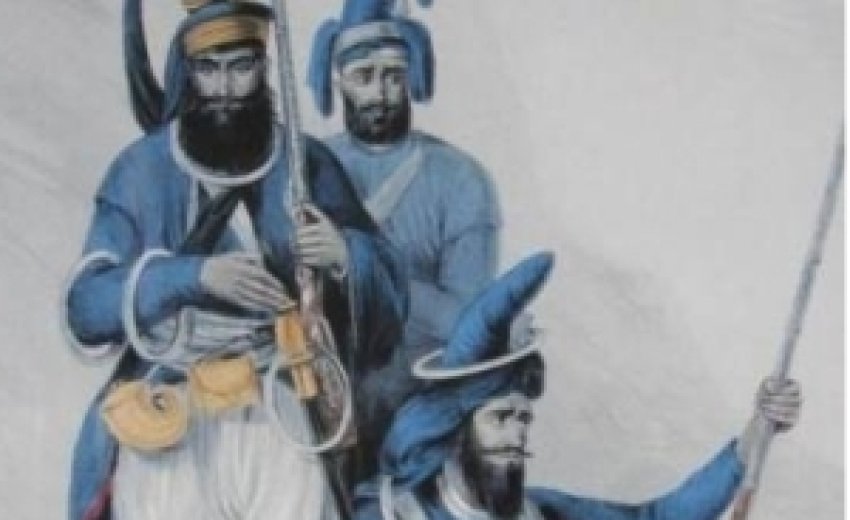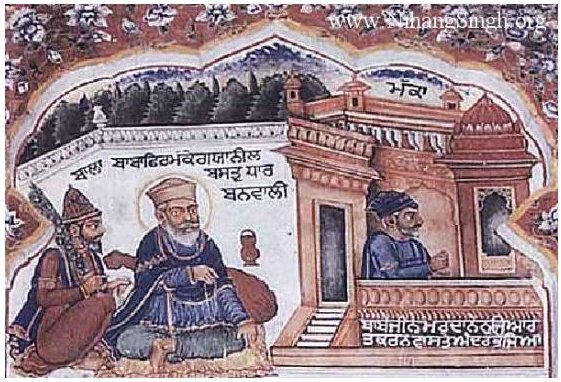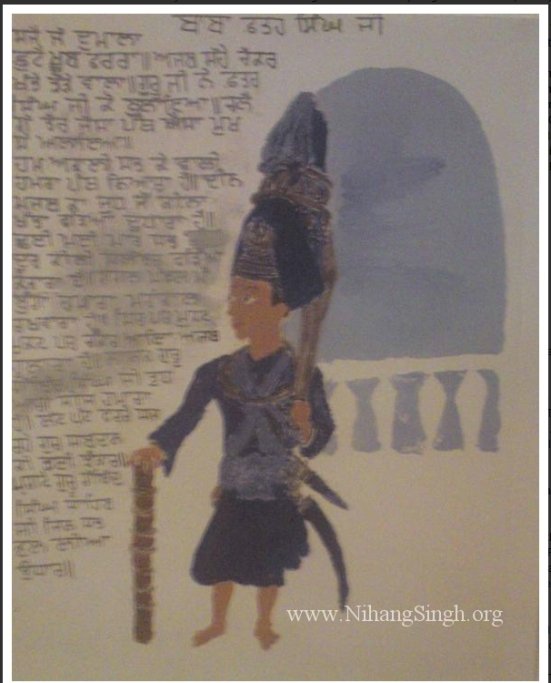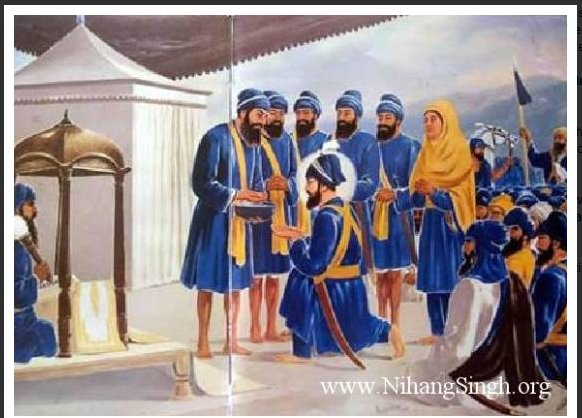| Neela Bana – Blue Uniform of the Nihang Singh | ||||||||||
|
Introduction “Blue clothing has been ordained in the Rehat of Sri Guru Gobind Singh Ji. At the time the Akali Panth was created the colour blue was chosen. Our Nishan Sahib (battle standards) are blue, I do not know why this tradition of orange/yellow Nishan Sahibs has come about. We are the Panth of Akaal Purakh (Timeless Being) and blue is the colour we have been decorated with. For this reason where there is an encampment of Nihang Singhs a blue battle standard stands high, this is the symbol of our panth. So Nihang Singhs are the Akali Singhs, this is the panth of the Guru and this is the uniform of the panth.” (Jathedar Baba Santa Singh Ji 96 Krori, Audio Recording May 1996)
Sri Guru Nanak Dev Ji and the Blue Bana ‘Baba Nanak then went to Mecca wearing blue clothing.’ (Bhai Gurdas Ji Vaaran, Vaal 1 Pauree 32) One of the foremost occasions when the colour blue was adorned within the Sikh tradition was at the time of Sri Guru Nanak Dev Ji. Kavi Santokh notes in the Sri Nanak Parkash Granth that when the first Guru was travelling to visit Mecca they were dressed in blue (neel bastr), carrying a spear/shaft and also had a kard (small knife) on their body. Jathedar Baba Trilok Singh of Tarna Dal (Khyaleai) states; “The primal Guru Satguru Nanak Dev Ji were the first to adorn the guise of the Nihang Singhs. They themselves wore the blue bana when visiting Mecca and on their journey also took necessary weapons with them. This was the form that the Nihang Singhs later adopted, dressed in blue adorning weapons. Thus in a sense Sri Guru Nanak Dev Ji themselves were the first Nihang Singh.” (Audio interview, February 2009)
‘The Guru's Army shall sit at the throne of Delhi. Umbrellas of kingship shall sway over their heads. All shall be content. From East to West all shall be conquered. None shall challenge the Khalsa. All humanity shall become one. In the kingdom of the True King, Satjug shall be established. The Khalsa Panth shall rule. The arrows of death shall not touch them. The Army of the Timeless shall grow and spread like locusts. All shall wear vestments of blue; no one else shall be seen. Listen Qazi Rukan Din, The Singhs shall rule.’ (Karni Nama) Furthermore, when speaking with Kaarun who was one of the most senior officials at Mecca, Sri Guru Nanak Dev Ji also answered his questions on the future in a conversation later transcribed and titled Raj Nama; ‘When I put on my tenth dress I shall be called Gobind Singh. Then shall all Singhs wear their hair. They shall accept the 'Pahaul' of the two-edged Sword. Then shall the Khalsa be established and men shall exclaim 'Vaheguru'. The four races shall become one and the same; the five weapons shall be worn by all. In Kalyug they shall array themselves in vestments of blue; The name of the Khalsa shall be everywhere. In the time of Aurangzeb the wondrous Khalsa shall arise. Then shall battles be waged, Endless war shall ensue and fighting shall follow year after year. They shall place the name of Gobind Singh in their hearts. When many heads shall be rendered up the Empire of the Khalsa shall prevail.’(Raj Nama) Evidently, discussion on the origins of the blue bana worn by Nihang Singhs begins at Sri Guru Nanak Dev Ji, something which contemporary analysts of Nihang traditions largely overlooked. Origins of the Akaali Bana There are two main stories relating to the validation of the blue bana of the Khalsa during the reign of Sri Guru Gobind Singh Ji. The stories are often presented as mutually exclusive which creates some doubt on the validity of these stories. This confusion is indeed primarily a result of writers failing to consult the Nihangs on their own traditions before writing or speaking on them. The first story relates to Baba Fateh singh Ji who was the youngest Sahibzada (Prince) of the tenth Guru. ‘Congregation which had come to visit Sri Guru Gobind Singh Ji Maharaj asked the Guru to bestow them with the blessed vision of Akal Purakh (Timeless Being). The Guru instructed their youngest Prince Baba Fateh Singh Ji, who at the time was in the Guru’s lap, to give the congregation a sight of Akal Purakh. Baba Fateh Singh Ji proceeded to the room where the Guru’s treasury was kept where he closed the door and adorned himself in blue clothing. He also tied a high dummala (conical turban) brandishing a farla (loose cloth coming from within the turban), getting ready like this he made his way to Maharaj. The wearer of the plume (Guru Gobind Singh Ji) called on the congregation to arise as Akaal Purakh was proceeding to give their blessed sight. All of the congregation, including Maharaj, saluted his arrival and sat him on a high palanquin. All bowed to pay their respects because he was not Baba Fateh Singh, but was the very form of Akaal Purakh’. (Sant Lal Singh Nihang, Akaal Purakh Ki Fauj, Page 6)
‘We are the Akali’s (immortals), we universally belong to all yet our path is unique and distinct.’ (Salok Dumale Da) From this episode we learn that the blue bana resembles the very form of Akaal Purakh hence it is also called the Akali bana. Furthermore, that the Tenth Guru granted a boon that a Panth would flourish bearing the form of Akaal – the Akali Panth or path of the immortals. For this reason, Akali’s who today are more commonly called Nihang Singhs hold Baba Fateh Singh to be the eternal Jathedar (Supreme General) of their armies and epitome of the Nihang ways. The second widely acclaimed story on the origins of the blue bana and Akali Panth relates to Bhai Maan Singh. He was one of Sri Guru Gobind Singh Ji’s most beloved Singhs and is also believed to have received a similar boon by the Tenth Guru. When Sri Guru Gobind Singh Ji left the battle of Chamkaur at the order of the Khalsa Panth, they were accompanied by Bhai Maan Singh a few other devotees through the jungle of Machiwara around December 1705. The popular account of this story is that when Sri Guru Gobind Singh removed their blue garments which they had adorned dressed as Ucha Da Pir, Bhai Maan Singh kept a small piece of blue cloth and the Guru replied that the there would be an order of warriors dressed in blue to commemorate his devotion. Another story noted by Kavi Santokh Singh is that when Bhai Maan Singh presented the Guru with some Sukha (giver of piece – cannabis which was used for its medicinal and spiritual purposes) the Guru was pleased and granted a boon that; ‘There will be many in the Panth Khalsa who shall dress like you and they shall also possess your great character and mindset. Their name will be Nihang and there shall be many of these Akali’s.’ (Gur Partap Suraj, Rut 6, Ansu 44)
‘This was the same Baba Maan Singh Nihang who at Sri Anandpur Sahib was immersed in the service of the young Baba Fateh Singh, he looked after and played with the Prince as a young child. And the special warrior bana which Baba Fateh Singh had worn when he roared into the holy court of Guru Gobind Singh and obtained the boon that the order of the Nihangs would forever be dressed as he was, the same bana he blessed to Baba Maan Singh. Baba Fateh Singh shared this boon with Baba Maan Singh. After this Baba Maan Singh forever remained dressed in the Nihang bana and adorned a farla, he also had other Singhs dress like this too and become Nihangs. He stayed in Guru Gobind Singh Ji’s presence for a long time and participated in many battles.’ (Hazoori Sathi, page 146-147) Thus, to clarify Bhai Maan Singh closely attended to Baba Fateh Singh Ji, such that the boon given to the prince by the Tenth Guru was also bestowed on Bhai Maan Singh. Thus, it is unsurprising that in Sikh history we find reference to both Baba Fateh Singh and Bhai Maan Singh being the central figures of the Nihang Singh order and their blue bana. Those wearing the blue bana represent the very form of Akaal Purakh and hence Bhai Daya Singh writes in his rehatnama; ‘Recognise him as an Akali/form of Akaal who is adorned in blue garments.’ The Blue Bana in History On the occasion of Vaisakhi 1699 when Sri Guru Gobind Singh Ji manifested the Khalsa Panth to the world, the Panj Pyarai who were the primal members of the Khalsa were presented to the Sikhs dressed in blue robes. Bhai Gurdas Singh, a contemporary poet of the Tenth Guru writes; ‘Like this the Buchangi Singh (young warriors) were presented, adorned in blue garments.’ (Vaaran, Bhai Gurdas Singh) Thus, the original form of the Khalsa created by Sri Guru Gobind Singh Ji was that of the blue wearing Nihang Singhs. Verification of this and further evidence implying the importance of the colour blue, is found in the writings of Sri Guru Gobind Singh Ji who instructs that; ‘Arise the Khalsa Panth, the third path (distinct from Hindu and Muslum religion). Awaken warrior Singhs adorned in blue clothing.’ (Chand 6, Uggardanti, found in ancient smaller manuscripts and some forms of Dasam Sri Guru Granth Sahib Ji) Bhatt Sarroop Singh in the 18th Century text ‘Guru Kian Sakhian’ notes that upon creating the Khalsa, the Tenth Guru instructed
‘The colour red which the Guru had forbidden, arrogantly he (Banda Bahadur) had his followers dress in this... They stopped the practise of wearing blue clothes and even on their heads wore red turbans.’ (Pracchin Panth Parkash, Part 1, Page 376) It is not just Sikh sources which confirm blue as the primary colour of the Khalsa. Many European observers make reference to the colour blue, noting that it was ordained by the Tenth Guru and maintained primarily by the Akali/Nihang Sikhs. Lietenaunt Joseph Davey Cunningham notes in the first half of the nineteenth century; ‘Besides the regular confederacies, with their moderate degree of subordination, there was a body of men who threw off all subjection to earthly governors, and who peculiarly represented the religious element of Sikhism. These were the ‘Akalis’, or immortals, or rather the soldiers of God, who, with their blue dress and bracelets of steel, claimed for themselves the direct institution of (Guru) Gobind Singh.’ (History of the Sikhs, page 110) Various British references to the colour blue and the Khalsa can be found in the narratives of travellers or the journals of those serving in the military. Other European travellers also make similar observations. The German Baron Charles Hugel notes in the instructions given by the Tenth Guru to the Khalsa; ‘...that a weapon of steel should be their symbol, and blue (now worn primarily by the fanatics called Akali or immortals) their uniform...’ (Kashmir und das Reich der Siek, also features in North British Review volume 28, 1845) Thus a range of sources, in different languages and from various time periods confirm that the original Khalsa was created in blue garments and that the Nihang or Akali warriors remained true to the blue robes of the Khalsa through the centuries despite persecution, attempted reforms and modernisation. Earning the Bana In the present times Nihang Singhs continue to maintain the colour blue as their prime colour and continue adorning their bana. Traditionally the bana is earned within from within a Nihang battalion and permission to wear bana is granted by a Nihang chief. Nihang Darshan Singh; “He was a man from a rich family and when he came to Sabo Ki Talwandi, seeing the Nihangs he was so fascinated and instantly fell in love with our lifestyle that he went to Baba Santa Singh and requested to be initiated a Nihang Singh himself. Baba Santa Singh declined several times saying that this was not the path for him and that he should carry on living his comfortable lifestyle. Baba Santa Singh pointed to his jewellery and said “this is not how we live”, the man took off his gold rings and threw them into the sarovar (holy pool). Baba Santa Singh gave him one of his old Kacherrae (shorts) and gave him and old sack to wear in place of his clothing. For one year he lived like this and did service for the Khalsa wearing only a sack. After one year Baba Santa Singh gave him and old bana, it was one of his own. He went on to become a great Singh, did a tremendous amount of service and meditation. He maintained a great amount of humility; he passed away just a few years ago. He never had a kasherra or bana made, he would only accept Baba Santa Singhs own clothes. He attained great spiritual heights before passing away.” (Audio recording, August 2006) This story illustrates how much value is given to the bana, it is not just a item of clothing worn for fashionable purposes. Anyone who wears the bana worn by Shaheed Singho (martyrs) is expected to die for the honour of the bana. Traditionally, one year was the standard time for which a new recruit was expected to perform service and learn the ways of the Nihangs before adorning the bana. Thus, by having to earn ones bana its worth is likely to be appreciated. However, this practise is somewhat dying out and many individuals now wear bana without any knowledge of Nihang traditions, or without any spiritual practise which as mentioned earlier is prerequisite for wearing bana. Wearing the bana without knowledge of traditions leads to a dilution of practises and misrepresentation of the Nihang order. For example in recent years there has been a rise in those who wear a pyjama or bottoms with a bana, something which is forbidden in the Nihang Rehat. Those who wear bana appearing to be Nihangs but do not follow Khalsa traditions or accompany the bana with spiritual practise are called ‘nang’, meaning naked. Nihang Baba Avtar Singh states; It is widely accepted that in the current times there is greater leniency upon those wishing to wear Bana. Giani Kirpal Singh, a student of Baba Mitt Singh and one time scribe of the Budha Dal notes the strenuous process which one had to go through before joining the Budha Dal: ‘The traditional way that the Budha Dal operated was that for about 10-12 years those wishing to take Amrit (divine nectar used in Khalsa initiation ceremony) would be instructed to serve the community. They would be made to wash iron utensils and scrub them with sand until they would shine. They would be told to bring firewood and also tend to the fire. They would look after the horses, cut grass and feed them, pick up their droppings and clean their stables. After going through all this effort only then where they blessed with amrit and given a bana. First they would be given a Kasherra (shorts), a dastar (turban) and a shawl like item with which to cover their body, this was so that they would have to kill all desires of the mind before being given the priceless gift of the bana... In the temporary age nor (do some Singh) do any seva (selfless service), nor do they perform any simran (contemplative meditation) or any spiritual wealth. They take amrit and go back home to live comfortably, take off their bana and kirpan (sword). They sit in social groups and drink alcohol and take drugs. What, is this Sikhi? No it is not, do not deceive yourself.’ (Doh Gursikh Nimolak Heereh, page 53) While this protocol is no longer in place, Nihangs today are reminded of the old traditions so as not to forget the importance and value of bana. There are lay members of the Nihang community who do not where bana or may do so partially. These may either be shardaloo – devotees, those who have great faith in and adore the Guru’s Nihangs, or Singhs who live a family lifestyle where it is not possible to always stay in bana for various reasons. Nonetheless, they retain the upmost respect for the Bana of the Guru and may from time to time also wear the bana. Conclusion Evidently, history strongly suggests blue is the primary colour of the Khalsa and that this has been preserved by the Nihang Singhs. This is illustrated most significantly in the Uggardanti, written by Sri Guru Gobind Singh Ji. The blue bana was first worn by Sri Guru Nanak Dev Ji who also prophesised the rising of the Khalsa army dressed in blue. The young prince Baba Fateh Singh and their attendant Bhai Maan Singh Nihang are considered the first to adopt the blue bana, the form of Akaal Purakh, and where given blessings that the Nihang order will forever thrive in their memory. It was also in blue garments that the Tenth Guru dressed the Khalsa Panth in 1699, and Nihangs today have still retained the original form of the Khalsa created by Sri Guru Gobind Singh Ji. © Copyright 2008-2010 www.NihangSingh.org |






